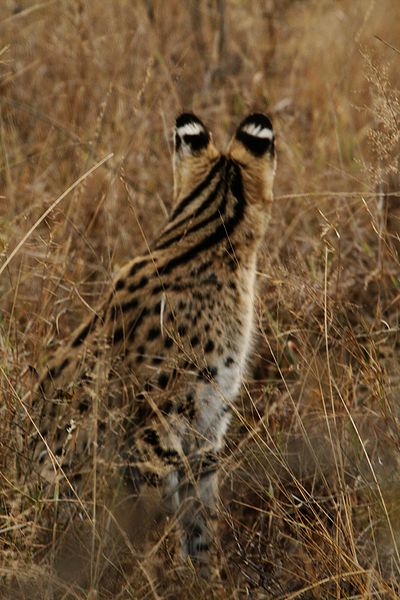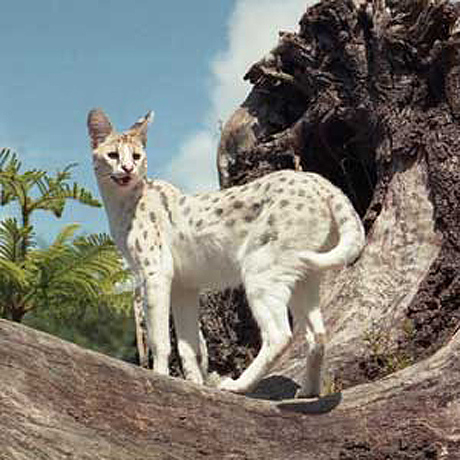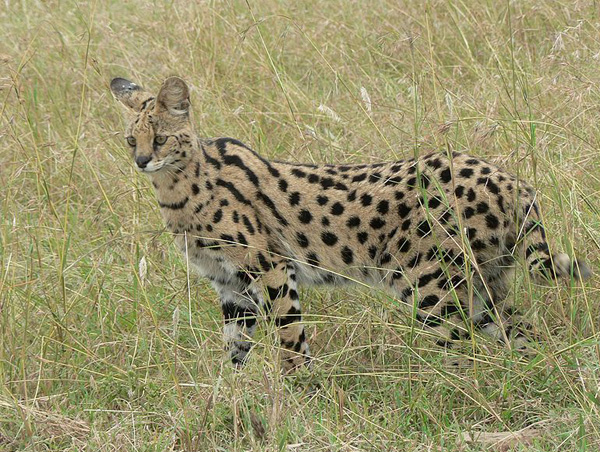Cat of the Month ~ March 2011
The Serval (Leptailurus Serval), is a medium-sized African wild cat which has lion and cheetah ancestors. (It is the cheetah which is thought to have descended from ancient Servals).
The serval is native to Africa, where it widely distributed south of the Sahara.
Its main habitat is the savanna, although the light coloured (melanistic) strain of this animal are more usually found in mountainous areas at elevations up to 3,000 Metres or 10,000 ft
The Serval needs rivers and streams within its territory, so it does not live in semi-deserts or dry steppes. Servals also avoid dense equatorial jungles, although they may be found along forest fringes. They are able to climb and swim, but seldom do so.
Servals are nocturnal, and so hunt mostly at night, unless disturbed by human activity or the presence of larger nocturnal predators. Although the serval is specialized for catching rodents, it is an opportunistic predator whose diet also includes birds and small mammals, fish, and frogs. It has also been seen feeding on larger animals, such as deer, gazelle, and springbok. The Serval eats very quickly, sometimes too quickly, causing it to gag and regurgitate due to clogging in the throat. Small prey are though devoured whole. Like many cats, Servals are able to purr. The Serval also has a high-pitched call, and can hiss, cackle, growl and meow.
As part of its adaptations for hunting in the savannas, the Serval has extremely long legs (the longest of all cats, relative to body size) for jumping, which also help it achieve a top speed of 80 kilometres per hour (50 mph).
The long legs (and neck) also allow the Serval to see over tall grasses, while its very large ears are used to detect prey, even those burrowing underground. Servals have been known to dig into burrows in search of underground prey, and to leap 2 to 3.6 metres into the air to grab birds in flight or to pounce on ground prey. While hunting, the Serval may pause for up to 15 minutes at a time to listen with eyes closed.

The eyespot markings or ocellus are used to signal
to Serval kittens when hunting.
The Serval then is an proficient killer, catching prey on an average of 50% of attempts (with a 67% success rate at night), compared to around one in ten attempts for most species of cat.
Servals are extremely intelligent, and demonstrate remarkable problem-solving ability, making them notorious for getting into mischief, as well as easily outwitting their prey, and eluding other predators. The Serval will often play with its captured prey for several minutes, before consuming it (where have we seen that before, Ed.). In most situations, Servals will ferociously defend their food against attempted theft by others. Males can be more aggressive than females.
Like most cats, Servals are solitary, nocturnal animals. They are known to travel as much as 3 to 4 Kilometres each night in search of food. Females defend home ranges of 10 to 20 square kilometres depending on local prey availability, while males defend larger territories of 10 to 30 square kilometres. They mark their territory by spraying urine onto prominent objects such as bushes, or, less frequently, by scraping fresh urine into the ground with their claws. Threat displays between hostile Servals are often highly exaggerated, with the animals flattening their ears and arching their backs, baring their teeth, and nodding their heads vigorously. In direct confrontation, they lash out with their long forelegs and make sharp barking sounds and loud growls.

Servals are able to give birth to multiple litters throughout the year, but commonly only do so if the earlier litters die shortly after birth. Gestation lasts from 66 to 77 days and commonly results in the birth of two kittens, although sometimes as few as one or as many as four have been recorded.
The kittens are born in dense vegetation, or sheltered locations. If such an ideal location is not available, a place behind a shrub may be sufficient. The kittens weigh around 250 grams (8.8 oz) at birth, and are initially blind and helpless, with a coat of off-white woolly hair. They open their eyes at nine to thirteen days of age, and begin to take solid food after around a month. At around six months, they acquire their permanent canine teeth and begin to hunt for themselves; they leave their mother at about twelve months of age.
Servals have dwindled in numbers due to human population taking over their habitat and also hunting for their pelts. The Serval is sometimes preyed upon by the Leopard and other large cats. The Serval is listed in CITES Appendix 2, indicating that it is “not necessarily now threatened with extinction but that may become so unless trade is closely controlled.”
Servals have historically been kept as pets in Africa, but only in the Botswana households. They were also used to pull small grain carts in ancient Egypt. The Ancient Egyptians worshipped the Serval as gods, and kept them as pets. More recently, they have been kept as pets in North America and Europe. Servals develop an intense emotional bond with their original owners. Often, they will choose one member of the human family they live with to form an especially close and intense bond. However, once they have bonded with a particular human family, Servals do not easily accept new owners or surroundings, and they may become quite unhappy if separated or placed with other families. For this reason, anyone taking in a Serval must be willing to house and keep the Serval for its entire life.
Recently, Servals have been bred with the domestic cat to create a hybrid breed of domestic cat called the Savannah. These animals tend to be smaller than the Serval, but retain the markings and color of the Serval. These animals are more tolerant of multiple owners, are more reliably litter trained, and tend to be more social with strangers. However, because the breeding can be difficult, the first generation (F1) animals tend to remain less common and quite expensive (as cat breeds go). Most states consider the product of a wild animal and a domestic cat to be a domestic cat, and therefore regulations for owning these animals tend to be similar to owning any domestic cat.
[Thanks to Wikipedia for the original source of facts about the Serval – All the references about this wonderful cat are sited on Wikipedia page]


